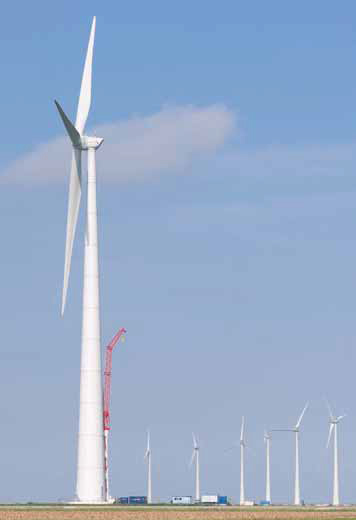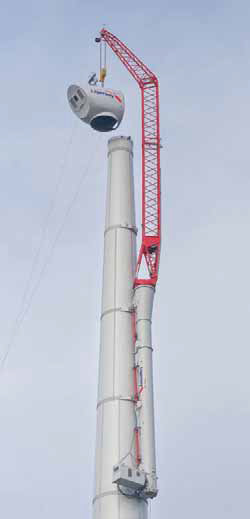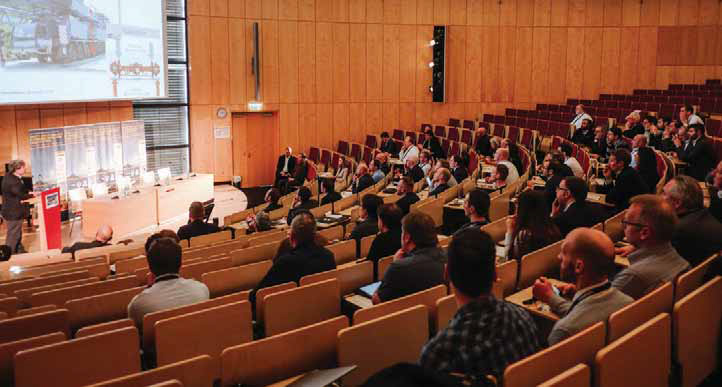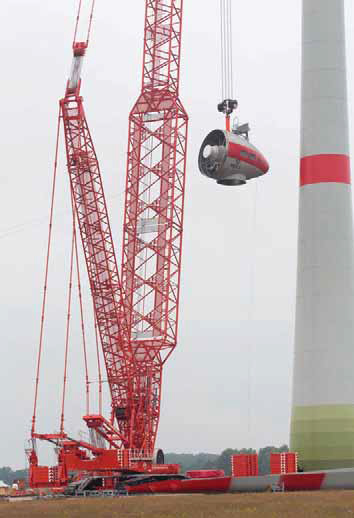Lifting’s ultramarathon
26 April 2018Wind turbine erection is one of the lifting and special transport industry’s most challenging tasks. In recent years, European trade association ESTA and manufacturers’ group the FEM have run a series of expert summits focussed on safety in the sector. At this year’s event in Hamburg, turbine manufacturers’ group VDMA Power Systems offered its support. Will North reports on the event, and on new technologies aimed at the sector.
If the lifting industry was competitive sport, the wind turbine sector would be the sector’s multi-day desert ultramarathon: requiring peak performance every day, in the most challenging conditions, day after day, for weeks or months on end.
At the Bucerius Law School in Hamburg this March, speakers explained some of the challenges facing lifting and transport firms.
The core of the challenge is the ever-increasing size of wind turbine components. As speakers explained, power generation contracts in many European markets are awarded in a reverse auction process, where developers bid to win projects on a lowest cost of energy basis.
The advantage of this approach is that it keeps consumer costs down, and promotes innovation. In wind, that innovation means bigger and bigger turbines, with larger nacelles, longer bladers, and higher hub heights.
Opening the summit, Uwe Sarrazin, head of global education and learning at GE Power and Water, explained that this trend has no clear limit: towers will get taller, nacelles will increasingly weigh over 100t, perhaps requiring assembly ‘up tower’, and blades will get longer.
Hans Henrik Grøn, logistics director at Siemens Gamesa Renewable Energy offered insight into the likely next step in component sizes. Overall turbine diameter will increase to up to 170m, with blades reaching 75m.
Lars Schødt, area sales manager for TII Sales, has many years experience of the demands of special transport firms serving the sector. He has observed that, even though the biggest turbines are initially designed to be installed offshore, developers regularly find ways to install them on land. And, of course, even where components are destined for offshore use, they often have to be transported on land.
Klaus Meissner, director, competence center engineering systems, product safety and IP, has spoken at events around the world, using simple tools to demonstrate the physics of turbine lifts. His demonstrations highlight the point that, being designed to catch as much of the wind’s force as possible, turbine blades are particularly susceptible to high winds during lifting.
Meissner noted accidents have also occured in high winds even when crawler cranes are idle. Meissner stressed that crawlers must be boomed down in such cases. An audience member pointed out that is sometimes difficult to find space for this; Meissner made clear that safety demands space is made.
David Collett, managing director of the eponymous special transport firm and president of ESTA, also emphasised the importance of planning wind farms with lifting and transport in mind. As blades get longer, manouevring around sites becomes harder. Collett showed how wind farm roads could be planned to reduce sharp turns. He also called for broad standards for how turbine components are carried, making it easier to ensure they are safely lashed to trailers when travelling on gradients. He added that while there are ISO standards for how roads are built, there are not currently standards for the design of roads suitable for specific special transport loads like turbine components.
Collett said that as turbine blades had reached lengths of 55m, a step change was demanded in trailer design; a similar step change would be demanded as blade lengths reached lengths of 80m.
Wind farms require lifting devices able to lift heavy loads to great heights in high winds; they need space for assembly and boom down of cranes; and they need transporters able to carry heavy and long loads. Over the following pages are examples of how the mobile and tower crane, alternative lifting, and transport sectors have responded.
The mobile method
The most common way to assemble a wind turbine uses a mobile crane, with either a telescopic or lattice boom. On many jobs, telescopic boom cranes are favoured, as they can reach high hub heights without needing an equivalent length of ground for boom assembly and for lowering of the boom in high winds.
In the aughts, the demands of the sector prompted some exciting innovations in telescopic boom crane design.
One particularly striking example was Manitowoc’s GTK1100, which mounted an all terrain crane upper on a telescopic tower and SPMTstyle carrier.
Similarly striking was Liebherr LTR 11200, which mounted the upperstructure of Liebherr’s biggest all terrain on a crawler carrier.
In recent years, however, turbine sizes have increased beyond the reach of current telescopic boom cranes. At the same time, everyone in the industry has become aware of the dangers posed by high winds.
One of the key crane classes for this sector is now, as Stuart Anderson discussed in our March issue, the 600-750t class of crawler cranes. These cranes are now routinely used in turbine erection. But even here, the wind turbine manufacturers and wind farm developers have pushed the cranes’ capabilities.
One day, perhaps, we will see the sector demanding even larger cranes on a regular basis. Already, 1,000t capacity crawlers are often used to erect wind farms.
In the meantime though, crane manufacturers have focused on building new boom systems that increase the capacity of cranes in this class.
Terex’s approach to this problem is the Boom Booster kit for its Superlift 3800, launched in 2015. Drawing on technology developed the previous year for the giant Demag CC800-1, the Boom Booster uses extra wide boom sections to increase performance on key parts of the load chart.
Importantly for the wind turbine sector, this increases the crane’s resistance to side loading from high winds and the sail effect of blades and rotor assemblies.
Liebherr similarly focussed on improving existing crane’s performance, starting with the PowerBoom system for its largest crawlers, the LR11000, LR11350, and LR13000.
In 2017, Liebherr launched a new ‘SX’ boom system for its 750t crawler and lattice boom truck crane, the LR1750/2 and LG1750.
The SX systems use a choice of different section sizes at the base of the boom: instead of 3.5m wide lattice sections, two sections each 14m in length (SX2 system) or three each 14m in length (SX3 system), with a width of 6m. An adapter allows these to be used with existing boom pieces.
The system allows crane owners to erect turbines to heights of up to 165m, lifting components of up to 120t.
Crawlers will continue to dominate the sector. As discussed at the ESTA summit, however, the space needed for boom assembly and emergency boom down, means that novel approaches are needed.
Towering benefits
For many, if not most, wind farms, mobile cranes will be the prefered option. But now, many crane owners and project specialists, are increasingly looking to tower cranes for some jobs.
Part of the reason for using mobiles has been a clear instruction from wind turbine companies: ‘Don’t touch the tower!’, which prevented tying-in to the tower. As mobile cranes show their limits though, both turbine and crane manufacturers have looked again at the issue.
Robert Strohmeier, project manager, Liebherr Biberach explained the company has developed two of its tower cranes for use on wind farms, the flat-top 1000 EC-B 125, and a version of the hammerhead 630 EC-H 70 Litronic. These cranes can be used safely on sites with wind speeds of 18m/s.
The flat-top has a maximum capacity of 125t. It is designed for work on turbines with hub heights over 120m. It uses a new fast erection system, that allows the crane to be assembled twice as fast as with previous techniques. It is freestanding up to 100m, and can be raised to 195m with just one tie-in.
The hammerhead crane lifts up to 70t. Its maximum freestanding hook height is 93.1m, and it can reach a hook height of 151m with just one tie-in.
Liebherr has developed a tie-in system for wind turbines, using a special turbine mast section.
The cranes can be mounted using a reusable base system, which allows the crane to be mounted close to the tower, and can be used later by smaller tower cranes for maintenance work on the turbine.
As is often the case, project specialists have also pushed innovation in this sector.
Back in 2012, Sarens formed a joint venture with Wilbert, aimed at developing a fleet of heavy lift tower cranes, supported by other lifting equipment. The venture, Wilbert Sarens Vermietung (WSV), developed a concept for tower cranes that can be used freestanding to ‘considerable’ heights, lifting loads of up to 128t at speeds of 10m/s. The joint venture said it would offer nine Wilbert WT 2405L cranes, and two further tower cranes from Wolff.
More recently, ALE has announced that it has been using two Krøll heavy luffers on a project in Thailand, the Wind Energy Holdings’ Thepharak wind farm. The cranes are handling and lifting over 700 wind turbine components, weighing up to 120t each, on turbines with hub heights of 157m.
The K1650L cranes were chosen as the low counterweight, increased visibility, quick assembly functionality, ability to work in high winds and with uneven or small hardstands optimises overall project efficiency.
“For this project, we are using the most time and cost-effective method to install [wind turbines] at this hub height. By using these compact pedestal cranes, the civil works and costs have been significantly reduced for our client.
The crane has lifting capabilities like no other tower crane on the market and we are pleased with the good results in lifting and installation activities on the project so far,” explained Tommy Quik, project manager for ALE.
Re-thinking the problem
For at least ten years, engineers and inventors have been trying to find ways to erect wind turbines without needing a crane, reducing the size of hardstands and the need for lengthy rigging and set up.
Back in 2007, Scottish company ITI Energy worked on plans for a tower-climbing maintenance crane, dubbed the Orangutan. This idea, unfortunately, does not appear to have come to fruition.
More recently, two Dutch companies, Mammoet and Lagerwey, have developed cranes that assemble the entire turbine, climbing the tower as they go.
Wind turbine manufacturer Lagerwey’s system, the Lagerwey Climbing Crane is currently the most well-developed, having been used on a prototype programme in 2017.
The fi rst iteration of the crane was designed to work on Lagerwey’s own Modular Steel Tower system. The company’s engineers are working on versions that will work on tubular and concrete towers.
The Lagerwey Climbing Crane arrives on site on three trailers, and can be assembled in a day using a 150–200t assist crane. It reaches a radius of 28m, and lifts up to 60t. It can hoist safely at wind speeds of up to 15m/s.
The company currently plans to put the crane to work on a second wind farm, building its own 2.5MW L100 turbines. At the same time, the company’s engineers are developing new, bigger turbines, with hub diameters of 146-158m, and a bigger version of the Lagerwey Climbing Crane that will be able to build them.
Mammoet last year announced a concept for two new cranes, the WTM100 and WTA250. The WTM100 is a wind turbine maintenance crane, able to lift up to 100t. It pulls itself up existing towers, using hoisting points on the turbine.
The WTA250 is a wind turbine assembly crane, able to lift up to 250t. Mammoet’s director, solutions and innovations, Wessel Helmens explains that this crane would be able to work on the biggest wind turbines, with hub diameters of up to 200m.
Currently Mammoet is working with wind turbine designer MECAL to develop a tower suitable for the WTA250. It will be installed on a guiderail that runs along the bottom turbine section and can lift the next section using the turbine’s tower as support. Once the next section is installed and equipped with a guiderail as well, the crane can push itself up along the rail and repeat the process for all of the subsequent turbine sections. Because the crane uses the turbine’s tower for support, the maximum lifting height of the crane is virtually limitless.
Another innovation of Mammoet’s also promises a new way to build turbines. The company recently announced a new confi guration for its giant Focus crane, developed with Piet Stoof. In Y-confi guration, this crawlerstyle crane can assemble itself vertically, without needing space for laying its boom down. While the company has initially marketed the Focus for applications in the petrochemical sector, Helmens says it ‘for sure’ could be used on wind turbines.
A lengthy journey
The challenges of the wind turbine industry don’t start at wind farm: they extend all the way to the OEM’s factory. As components get larger and heavier, transporting them safely becomes more of a challenge.
It’s a challenge that has prompted much innovation. At the factory, very heavy and large nacelles need to be moved around the plant. For this task, TII’s Scheuerle has developed an automated guided vehicle (AGV), designed to be used on the turbine production line.
All of the major special transport manufacturers have developed telescoping versions of their trailers, able to securely support turbine blades. One such, is Faymonville’s TeleMax trailer, which can be extended up to four times, in order to carry blades up to 65m.
In recent years, as wind farm developers look for new sites in harder to reach locations, companies like Scheuerle and Nooteboom have developed systems able to carry the very longest blades, up to around 70m, and, importantly, to angle them upwards so as to avoid obstacles on the road or to allow them to turn through tight corners in forests.
One of the most recent innovations in the sector has come from Goldhofer, which recently launched the FSH 10. This uses a scissor-lift to raise turbine blades. With the FSH, Goldhofer has developed a blade tip lifting device that can handle all standard rotor blades with a length of up to 75m, with a payload capacity of up to 10t and a lifting height of up to 10m.
The FSH 10 is designed as an autonomous system, with an integrated power unit to make it independent of the vehicle’s hydraulic and electrical systems. In order to negotiate difficult bends, the semitrailer can be retracted as the FSH is mounted on rails on the deck.
The first three units were sold to Belgian firm Adams Group, along with a new version of the company’s FTV blade transporter, the FTV 500.
The new transporter, a successor to the FTV 300, can be used on an SPMT or pulled trailer, to angle blades at up to 60°.
Adams Group’s founder and general manager, Peter Adams, says, “The FSH gives us a transport solution that puts us one step ahead of the competition—and enables us to offer rotor blade transport services with much shorter transport times on a highly cost-effective basis.”
Powering forward
The wind turbine industry has driven innovation in the lifting and transport sector. It has lead to the development of some of the biggest and most capable cranes and transporters, and some remarkable innovations.
But, it continues to pose considerable challenges. Lifting and transport companies find themselves squeezed by tight margins, which can lead to pressure to cut costs and even to overlook important safety issues. ESTA and the FEM, and now the VDMA Power Systems group, are doing valuable work to establish best practice in the sector, with well defined standards. Establishing how to work safely, and working together to plan how turbines will be erected, remains a vital task.
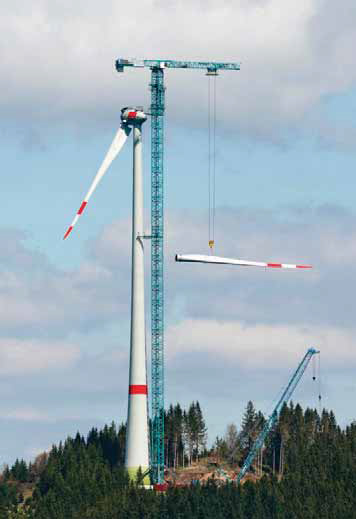 Tower cranes are increasingly used for wind turbine erection. A Liebherr 1000 EC-B 125 Litronic is used by Enercon.
Tower cranes are increasingly used for wind turbine erection. A Liebherr 1000 EC-B 125 Litronic is used by Enercon.
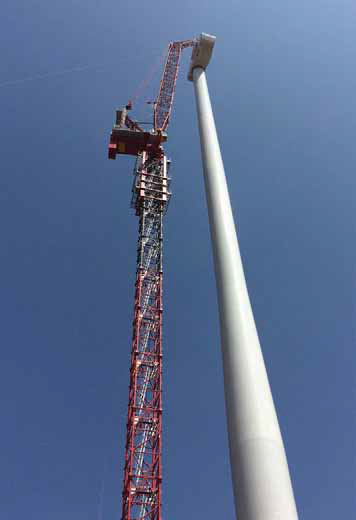 Tower cranes are increasingly used for wind turbine erection. ALE uses one of two Krøll K1650L tower cranes to install turbines on Wind Energy Holding’s Thepharak wind farm project, in Thailand.
Tower cranes are increasingly used for wind turbine erection. ALE uses one of two Krøll K1650L tower cranes to install turbines on Wind Energy Holding’s Thepharak wind farm project, in Thailand.
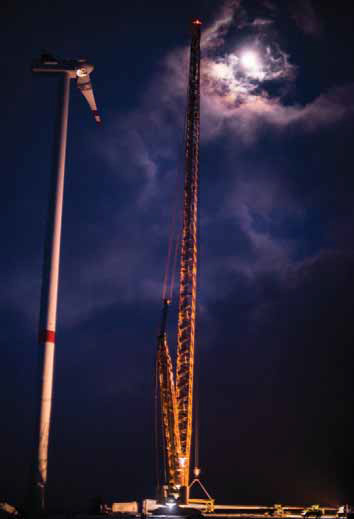 New boom systems increase the capacity of crawlers, particularly on wind turbine jobs. A Terex Superlift 3800 with Boom Booster kit is used by Franz Bracht to raise components to a hub height of 149m.
New boom systems increase the capacity of crawlers, particularly on wind turbine jobs. A Terex Superlift 3800 with Boom Booster kit is used by Franz Bracht to raise components to a hub height of 149m.
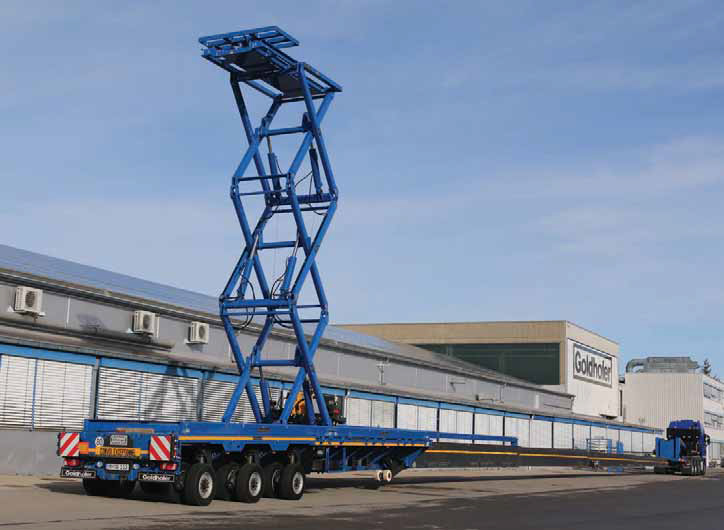 Goldhofer’s new FSH 10 device uses a scissor-lift style system to raise blade tips by up to 10m. It can be used with blades up to 75m long.
Goldhofer’s new FSH 10 device uses a scissor-lift style system to raise blade tips by up to 10m. It can be used with blades up to 75m long.
